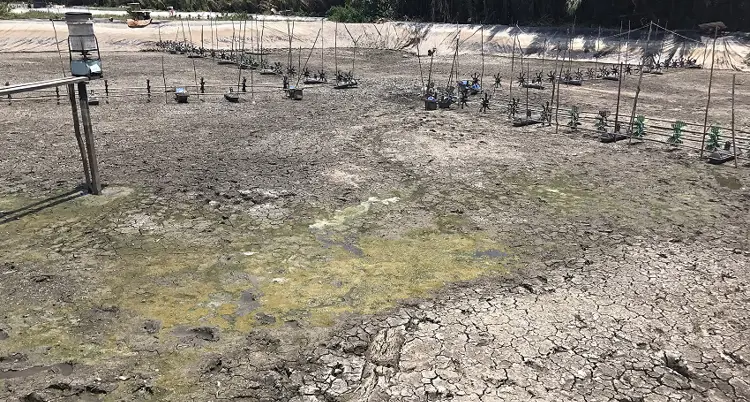Maintaining good water quality for a profitable aquaculture farm
Good water quality can mean the difference between a profitable aquaculture farm and a farm struggling to maintain performance. Although lake and river farming have their own challenges, there's a larger buffering capacity in lakes and a continuous water flow in rivers. Ponds, however, are much more challenging and require good management to ensure water quality is kept at a level that results in high performance of the cultured fish and shrimp.

Is a clean start the best start?
There are many different cycles taking place in an aquaculture pond, such as the nitrogen cycle and diurnal cycles related to oxygen and pH. Two of the most important driving factors for all these cycles are micro-organisms, including phytoplankton, zooplankton, and bacteria; and organic input in the form of aquafeed and waste produced by the cultured animals.
Starting with pond preparation, many farmers first remove the sludge (excess organic waste) which accumulated during the previous production cycle. This also removes many of the microorganisms from the previous cycle, including both beneficial and harmful bacteria. After sludge removal, the ponds are dried. This again removes any unwanted anaerobic bacteria that thrived during the previous production cycle. Finally, the ponds are disinfected to remove unwanted bacteria. This is the last step in preparing ponds before starting the new cycle. Unfortunately, all these steps, particularly the last one, create a vacuum for bacteria to recolonise. These bacteria will enter through the freshwater used to fill the ponds, and also in biofilms from a previous production cycle. Biofilms are extremely hardy and difficult to eliminate, allowing bacteria living in them to survive even the harshest conditions. In ponds that have been disinfected, recolonisation will favour opportunistic, fastgrowing bacteria, which also tend to be pathogenic bacteria. Fortunately, beneficial bacteria have time to catch up while the pond is made ready. In this step, probiotics should be added to accelerate the bacterial balance in the pond before stocking it with young fish or shrimp. The most commonly used probiotics are Bacillus spp and yeast microorganisms. Probiotics will consume excess fertilisation and also compete with the opportunistic bacteria, creating a more harmonious microbial culture in the ponds.
Using probiotics to maintain the microbial balance
During and after pond filling, natural recolonisation by bacteria is aided by fertilisation. Because ponds need phytoplankton to function as a natural feed in the early stages of production, they are fertilised to accelerate phytoplankton blooms. At the end of this continuous cycle, part of the bloom will eventually die off and settle on the pond floor, accumulating as organic waste. During the fertilisation process, it's good to have a continuous influx of beneficial (probiotic) bacteria to minimise the build-up of organic waste and ensure that opportunistic bacteria don't tip the microbial balance.
The animals in the pond grow, so too does the total amount of daily feed required for optimal growth
Reducing the toxicity of organic waste
In the initial stages, these different cycles can be kept under control without too much effort, thanks to the relatively large buffering capacity of the pond and the regular influx of probiotics. But as the animals in the pond grow, so too does the total amount of daily feed required for optimal growth. This also means that the risk of feed loss and waste production increases in line with animal growth. Waste fuels algae blooms which also affect the diurnal cycle of dissolved oxygen and dissolved CO2 in the photosynthetic/respiratory process. In addition, a lot of this waste will settle on the pond floor, eventually creating anaerobic conditions. These conditions can produce toxic substances such as H2S, CH4, and NH4. H2S is oxidized quickly but bottom dwellers are more exposed before oxidation takes place. Ammonia production can be a big problem when the pH increases because NH4 changes to NH3 which is toxic and can result in reduced animal health and also affect the gills. High algae blooms increase CO2 in the ponds which also increases pH. As was previously mentioned, an increased pH increases the toxic NH3 form of ammonia. Probiotics, Bacillus spp, and yeasts not only reduce the accumulation of organic waste on the pond floor under both aerobic and anaerobic conditions but also directly counteract pathogenic bacteria by competitive exclusion and secretion of exo-enzymes that can actively control pathogenic bacteria.
KOUDIJS POND QUALITY BOOSTER
To maintain good, healthy water quality, we recently introduced the Koudijs Pond Quality Booster probiotic mix. Koudijs Pond Quality Booster contains a specially selected base of minerals and trace elements to stimulate a balanced microbial biodiversity in the pond water and pond bottom.
Do you want to know more?
About the author

Maarten-Jay van Schoonhoven
Do you have any questions or would you like more information? Get in touch with Maarten Jay.
